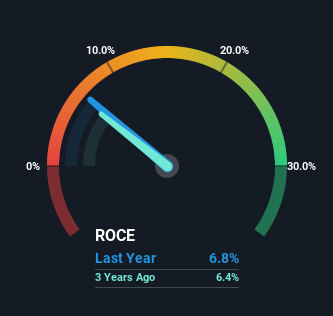- Canada
- /
- Retail Distributors
- /
- TSX:UNS
Some Investors May Be Worried About Uni-Select's (TSE:UNS) Returns On Capital
Finding a business that has the potential to grow substantially is not easy, but it is possible if we look at a few key financial metrics. One common approach is to try and find a company with returns on capital employed (ROCE) that are increasing, in conjunction with a growing amount of capital employed. Basically this means that a company has profitable initiatives that it can continue to reinvest in, which is a trait of a compounding machine. Having said that, from a first glance at Uni-Select (TSE:UNS) we aren't jumping out of our chairs at how returns are trending, but let's have a deeper look.
Return On Capital Employed (ROCE): What is it?
If you haven't worked with ROCE before, it measures the 'return' (pre-tax profit) a company generates from capital employed in its business. The formula for this calculation on Uni-Select is:
Return on Capital Employed = Earnings Before Interest and Tax (EBIT) ÷ (Total Assets - Current Liabilities)
0.068 = US$66m ÷ (US$1.3b - US$369m) (Based on the trailing twelve months to March 2022).
Thus, Uni-Select has an ROCE of 6.8%. Ultimately, that's a low return and it under-performs the Retail Distributors industry average of 14%.
See our latest analysis for Uni-Select

Above you can see how the current ROCE for Uni-Select compares to its prior returns on capital, but there's only so much you can tell from the past. If you're interested, you can view the analysts predictions in our free report on analyst forecasts for the company.
What Does the ROCE Trend For Uni-Select Tell Us?
When we looked at the ROCE trend at Uni-Select, we didn't gain much confidence. Over the last five years, returns on capital have decreased to 6.8% from 13% five years ago. Although, given both revenue and the amount of assets employed in the business have increased, it could suggest the company is investing in growth, and the extra capital has led to a short-term reduction in ROCE. And if the increased capital generates additional returns, the business, and thus shareholders, will benefit in the long run.
The Bottom Line
In summary, despite lower returns in the short term, we're encouraged to see that Uni-Select is reinvesting for growth and has higher sales as a result. These trends are starting to be recognized by investors since the stock has delivered a 15% gain to shareholders who've held over the last five years. So this stock may still be an appealing investment opportunity, if other fundamentals prove to be sound.
Since virtually every company faces some risks, it's worth knowing what they are, and we've spotted 3 warning signs for Uni-Select (of which 1 can't be ignored!) that you should know about.
While Uni-Select may not currently earn the highest returns, we've compiled a list of companies that currently earn more than 25% return on equity. Check out this free list here.
New: AI Stock Screener & Alerts
Our new AI Stock Screener scans the market every day to uncover opportunities.
• Dividend Powerhouses (3%+ Yield)
• Undervalued Small Caps with Insider Buying
• High growth Tech and AI Companies
Or build your own from over 50 metrics.
Have feedback on this article? Concerned about the content? Get in touch with us directly. Alternatively, email editorial-team (at) simplywallst.com.
This article by Simply Wall St is general in nature. We provide commentary based on historical data and analyst forecasts only using an unbiased methodology and our articles are not intended to be financial advice. It does not constitute a recommendation to buy or sell any stock, and does not take account of your objectives, or your financial situation. We aim to bring you long-term focused analysis driven by fundamental data. Note that our analysis may not factor in the latest price-sensitive company announcements or qualitative material. Simply Wall St has no position in any stocks mentioned.
About TSX:UNS
Uni-Select
Uni-Select Inc., together with its subsidiaries, distributes automotive refinish, and industrial coatings and related products in North America.
Flawless balance sheet with solid track record.
Similar Companies
Market Insights
Community Narratives



